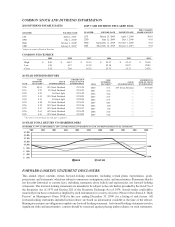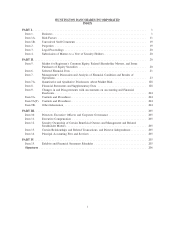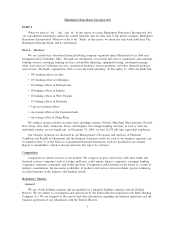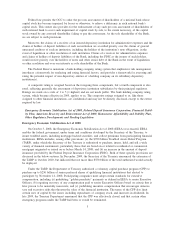Huntington National Bank 2009 Annual Report Download - page 16
Download and view the complete annual report
Please find page 16 of the 2009 Huntington National Bank annual report below. You can navigate through the pages in the report by either clicking on the pages listed below, or by using the keyword search tool below to find specific information within the annual report.determined b
y
allocatin
g
assets and specified off-balance sheet commitments into four wei
g
hted cate
g
ories
,
with hi
g
her wei
g
htin
g
assi
g
ned to cate
g
ories perceived as representin
gg
reater risk. The risk-based rati
o
represents capital divided b
y
total risk wei
g
hted assets. The levera
g
e ratio is core capital divided b
y
tota
l
assets adjusted as specified in the guidelines. The Bank is subject to substantially similar capital requirements
.
Generall
y
, under the applicable
g
uidelines, a financial institution’s capital is divided into two tiers.
Inst
i
tut
i
ons t
h
at must
i
ncorporate mar
k
et r
i
s
k
exposure
i
nto t
h
e
i
rr
i
s
k
-
b
ase
d
cap
i
ta
l
requ
i
rements ma
y
a
l
so
h
av
e
at
hi
r
d
t
i
er o
f
ca
pi
ta
li
nt
h
e
f
orm o
f
restr
i
cte
d
s
h
ort-term su
b
or
di
nate
dd
e
b
t. T
h
ese t
i
ers are
:
•“T
i
er 1”, or core cap
i
ta
l
,
i
nc
l
u
d
es tota
l
equ
i
t
y
p
l
us qua
lifyi
n
g
cap
i
ta
l
secur
i
t
i
es an
d
m
i
nor
i
t
yi
nterests,
exc
l
u
di
n
g
unrea
li
ze
dg
a
i
ns an
dl
osses accumu
l
ate
di
not
h
er compre
h
ens
i
ve
i
ncome, an
d
non-qua
lifyi
n
g
intan
g
ible and servicin
g
assets.
• “Tier 2”, or supplementar
y
capital, includes, amon
g
other thin
g
s, cumulative and limited-life preferre
d
s
tock, mandator
y
convertible securities, qualif
y
in
g
subordinated debt, and the allowance for credit
losses, up to 1.2
5
% of risk-wei
g
hted assets.
• “Tota
l
ca
pi
ta
l
”
i
sT
i
er 1
pl
us T
i
er 2 ca
pi
ta
l.
The Federal Reserve and the other federal bankin
g
re
g
ulators require that all intan
g
ible assets (net o
f
d
e
f
erre
d
tax), except or
igi
nate
d
or purc
h
ase
d
mort
g
a
g
e-serv
i
c
i
n
g
r
igh
ts, non-mort
g
a
g
e serv
i
c
i
n
g
assets, an
d
p
urc
h
ase
d
cre
di
t car
d
re
l
at
i
ons
hip
s,
b
e
d
e
d
ucte
df
rom T
i
er 1 ca
pi
ta
l
. However, t
h
e tota
l
amount o
f
t
h
ese
i
tems
included in ca
p
ital cannot exceed 100% of its Tier 1 ca
p
ital.
Under the risk-based
g
uidelines, financial institutions are required to maintain a risk-based ratio of 8%
,
with 4% bein
g
Tier 1 capital. The appropriate re
g
ulator
y
authorit
y
ma
y
set hi
g
her capital requirements whe
n
t
h
e
yb
e
li
eve an
i
nst
i
tut
i
on’s c
i
rcumstances warrant.
Un
d
er t
h
e
l
evera
g
e
g
u
id
e
li
nes,
fi
nanc
i
a
li
nst
i
tut
i
ons are requ
i
re
d
to ma
i
nta
i
na
l
evera
g
e rat
i
oo
f
at
l
eas
t
3%. T
h
em
i
n
i
mum rat
i
o
i
s app
li
ca
bl
eon
ly
to
fi
nanc
i
a
li
nst
i
tut
i
ons t
h
at meet certa
i
n spec
ifi
e
d
cr
i
ter
i
a,
includin
g
excellent asset qualit
y
,hi
g
h liquidit
y
, low interest rate risk exposure, and the hi
g
hest re
g
ulator
y
ratin
g
. Financial institutions not meetin
g
these criteria are required to maintain a minimum Tier 1 levera
ge
rat
i
oo
f
4%.
Spec
i
a
l
m
i
n
i
mum cap
i
ta
l
requ
i
rements app
ly
to equ
i
t
yi
nvestments
i
n non-
fi
nanc
i
a
l
compan
i
es. T
h
e
requirements consist of a series of deductions from Tier 1 capital that increase within a ran
g
e from 8% to 2
5%
of the ad
j
usted carr
y
in
g
value of the investment
.
Fa
il
ure to meet app
li
ca
bl
e cap
i
ta
lg
u
id
e
li
nes cou
ld
su
bj
ect t
h
e
fi
nanc
i
a
li
nst
i
tut
i
on to a var
i
et
y
o
f
enforcement remedies available to the federal re
g
ulator
y
authorities. These include limitations on the abilit
y
t
o
pa
ydi
v
id
en
d
s, t
h
e
i
ssuance
by
t
h
ere
g
u
l
ator
y
aut
h
or
i
t
y
o
f
a cap
i
ta
ldi
rect
i
ve to
i
ncrease cap
i
ta
l
,an
d
t
he
term
i
nat
i
on o
fd
epos
i
t
i
nsurance
by
t
h
e FDIC. In a
ddi
t
i
on, t
h
e
fi
nanc
i
a
li
nst
i
tut
i
on cou
ld b
esu
bj
ect to t
he
measures described below under “Prom
p
t Corrective Action” as a
pp
licable to “under-ca
p
italized” institutions
.
The risk-based capital standards of the Federal Reserve, the OCC, and the FDIC specif
y
that evaluation
s
b
y
the bankin
g
a
g
encies of a bank’s capital adequac
y
will include an assessment of the exposure to declines in
t
h
e econom
i
cva
l
ue o
f
t
h
e
b
an
k
’s cap
i
ta
ld
ue to c
h
an
g
es
i
n
i
nterest rates. T
h
ese
b
an
ki
n
g
a
g
enc
i
es
i
ssue
da
j
o
i
nt po
li
c
y
statement on
i
nterest rate r
i
s
kd
escr
ibi
n
g
pru
d
ent met
h
o
d
s
f
or mon
i
tor
i
n
g
suc
h
r
i
s
k
t
h
at re
ly
principall
y
on internal measures of exposure and active oversi
g
ht of risk mana
g
ement activities b
y
senio
r
managemen
t.
P
rom
p
t Corrective Action
T
h
eFe
d
era
l
De
p
os
i
t Insurance Cor
p
orat
i
on Im
p
rovement Act o
f
1991,
k
nown as FDICIA, re
q
u
i
res
f
e
d
era
l
b
an
ki
n
g
re
g
u
l
ator
y
aut
h
or
i
t
i
es to ta
k
e “prompt correct
i
ve act
i
on” w
i
t
h
respect to
d
epos
i
tor
yi
nst
i
tut
i
ons t
h
at
do
not meet minimum ca
p
ital re
q
uirements. For these
p
ur
p
oses, FDICIA establishes five ca
p
ital tiers: “well
-
cap
i
ta
li
ze
d
,” “a
d
equate
ly
-cap
i
ta
li
ze
d
,” “un
d
er-cap
i
ta
li
ze
d
,” “s
ig
n
ifi
cant
ly
un
d
er-cap
i
ta
li
ze
d
,” an
d
“cr
i
t
i
ca
lly
un
d
er-ca
pi
ta
li
ze
d
.
”
8
























